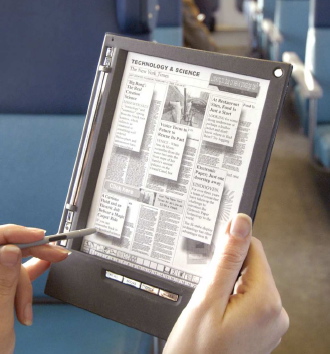
I work part time at a coffee shop that sells
The New York Times. One Sunday I had a customer pick one up and motion me to ring him up for it. The price? Six dollars. I couldn’t believe a newspaper costs more than a triple venti soy latte. I quickly gained my composure and said, “That’ll be $6, please.”
This small interaction got me thinking. I had heard about digital newspapers, but wasn’t sure how popular they are or how much of a difference they are making on the environment. After a little research and Googling around, I found some enlightening and eye-opening information.
At first glance, most people would assume that this question is a no brainer. Of course a digital newspaper is greener, because there’s no paper used and no transportation required. A recent study performed by KTH Centre for Sustainable Communications in Stockholm compared the environmental impact of producing and delivering a newspaper and the time and electricity it would take to read a digital edition online.
The research concluded that it takes the average person about 30 minutes to read the newspaper. With this amount of time, they found that both paper and digital versions make about the same environmental impact. Surprised and determined to find ways for this not be so, I’ve come up with a few ways that you can make reading a digital newspaper more eco-friendly.
- Read the digital paper for 10 to 15 minutes. Find the top stories that interest you and read those first. If you have time remaining, then go on to the stories of less interest.
- Don’t use your computer to read the newspaper. Use smaller, battery-operated devices such as an Internet-enabled phone or a Kindle. These devices use much less energy than a home computer or laptop. If you use these devices, you can read more than 10 minutes without worry.
- Use a sustainable source for your electricity, such as solar power or a biodiesel fuel generator. If you use these sources for energy, then the digital paper is much more eco-friendly than the paper version.
If you’re a stickler for the traditional paper newspaper, then find a used one at your local coffee shop and reuse it. Besides, it’s going to end up in the trash at the end of the day. You can also talk with your neighbors and develop a reading plan where the earliest riser gets the paper delivered to their house and then drops at the front door of the next person on the rising list. You can create a chain of five to seven people and save money and trees.
 I work part time at a coffee shop that sells The New York Times. One Sunday I had a customer pick one up and motion me to ring him up for it. The price? Six dollars. I couldn’t believe a newspaper costs more than a triple venti soy latte. I quickly gained my composure and said, “That’ll be $6, please.”
This small interaction got me thinking. I had heard about digital newspapers, but wasn’t sure how popular they are or how much of a difference they are making on the environment. After a little research and Googling around, I found some enlightening and eye-opening information.
At first glance, most people would assume that this question is a no brainer. Of course a digital newspaper is greener, because there’s no paper used and no transportation required. A recent study performed by KTH Centre for Sustainable Communications in Stockholm compared the environmental impact of producing and delivering a newspaper and the time and electricity it would take to read a digital edition online.
The research concluded that it takes the average person about 30 minutes to read the newspaper. With this amount of time, they found that both paper and digital versions make about the same environmental impact. Surprised and determined to find ways for this not be so, I’ve come up with a few ways that you can make reading a digital newspaper more eco-friendly.
I work part time at a coffee shop that sells The New York Times. One Sunday I had a customer pick one up and motion me to ring him up for it. The price? Six dollars. I couldn’t believe a newspaper costs more than a triple venti soy latte. I quickly gained my composure and said, “That’ll be $6, please.”
This small interaction got me thinking. I had heard about digital newspapers, but wasn’t sure how popular they are or how much of a difference they are making on the environment. After a little research and Googling around, I found some enlightening and eye-opening information.
At first glance, most people would assume that this question is a no brainer. Of course a digital newspaper is greener, because there’s no paper used and no transportation required. A recent study performed by KTH Centre for Sustainable Communications in Stockholm compared the environmental impact of producing and delivering a newspaper and the time and electricity it would take to read a digital edition online.
The research concluded that it takes the average person about 30 minutes to read the newspaper. With this amount of time, they found that both paper and digital versions make about the same environmental impact. Surprised and determined to find ways for this not be so, I’ve come up with a few ways that you can make reading a digital newspaper more eco-friendly.